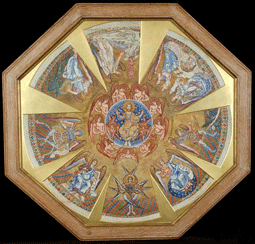Study of Mosaic: 'Christ surrounded by the Principalities and Powers of Heaven'
Baptistery Dome, San Marco, Venice. Thomas Matthews Rooke (1842-1942). Watercolour, bodycolour and gold on paper, 1879.
WorkThe subject of this study was mentioned by Ruskin in The Stones of Venice (1851-3).In that work, Ruskin asks the reader to imagine entering St Mark's. He directs our attention to 'the vaulting of the roof'. He explains 'that there are seen upon it two great circles, one surrounded by the "Principalities and powers in heavenly places," of which Milton has expressed the ancient division in the single massy line, "Thrones, Dominations, Princedoms, Virtues, Powers," and around the other, the Apostles; Christ the centre of both' (Works, 10, pp. 86-7).Ruskin returns to this subject in St Mark's Rest (1877-84):'Both cupolas have Christ for their central figure: surrounded, in that over the font, by the Apostles baptizing with water; in that over the altar, surrounded by the Powers of Heaven, baptizing with the Holy Ghost and with fire. Each of the Apostles, over the font, is seen baptizing in the country to which he is sent.' (Works, 24, p. 282).
ArtistT.M. Rooke (1842-1942) created many watercolour drawings for the Guild of St George. He first worked in an army agent's office before attending evening classes in art and became a student at the Royal Academy in 1868. The following year he was employed by William Morris's firm and became an assistant and close friend of Edward Burne-Jones.Rooke enjoyed success as an artist in his own right. Collection of the Guild of St George, Museums Sheffield
He painted large biblical scenes in a style influenced by Burne-Jones and Renaissance art, and exhibited at the Royal Academy. When Ruskin employed him, Rooke worked in a different style, drawing in watercolours and painting from life. Later, Rooke painted records of architecture for the Society for the Preservation of Pictorial Records of Ancient Works of Art.
Ruskin on MosaicIn the course of his correspondence with Rooke, Ruskin wrote that 'The real fact is that all Byzantine mosaic (and all Eastern colour) has splendour for its first object -- and its type is the peacock's tail.'He adds, for Rooke's benefit, that 'If your drawings glow and melt like that you are right': 'Peacock's tail in shade or light it may be -- and much sober brown in any light may mix with its violet and gold -- but that is what the mosaicist wanted to do, and for the most part did'.Ruskin concludes, provocatively, that 'All that is grey, cold, reserved, or modest, in these mosaics (in any other sense than a humming-bird or flamingo or pheasant -- or aforesaid peacock -- is modest) is European, mostly Roman, some of it German -- all of it bad.' (Works, 30, p. lviii). |



















